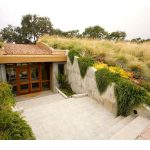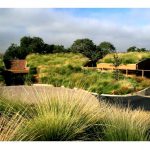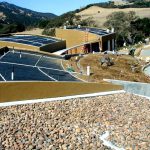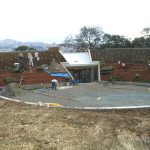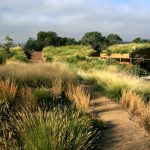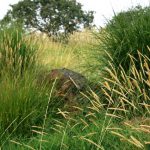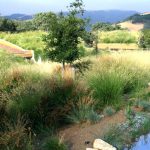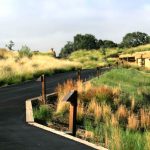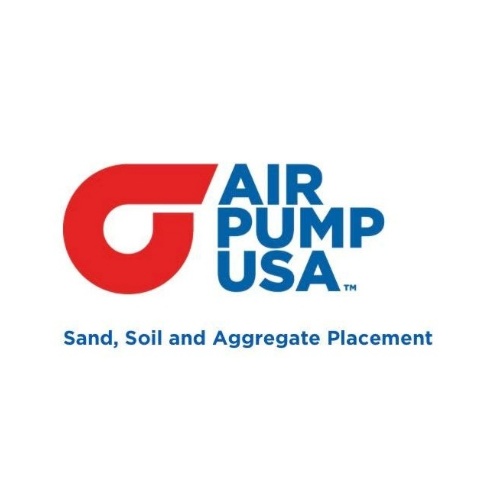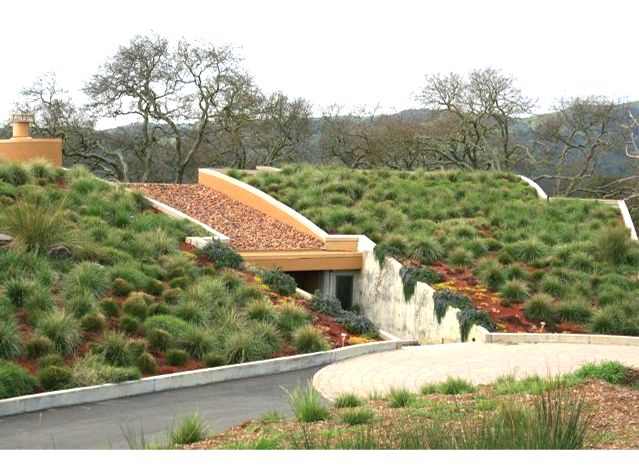
Additional Resources
For more info on this project, please visit www.mozaiclandscapedesign.com or contact the designer, Cynthia Tanyan of Mozaic Landscape Design at: P.O. Box 394; Sunol, CA 94586; 510.494.8500; cynthia@mozaiclandscapedesign.com.
The Buttner-Chang residence was a newly constructed home (completed 11/06) comprised of a modern style main house (about 4,100 sqft) with separate office and garage buildings (both approx. 800 sqft). Greenroofs (depth 5.5″) were designed by the architect for all the buildings, and sit atop sloping and curved barrel roofs. The main house roof slopes down from its peak, and ends at a retaining wall in front, which meets a native soil slope. Despite the very different soil depths and composition, one of the first objectives was to blur the distinction of greenroof and native soil so that from the front, house and front landscape appear as one continuous uphill slope with no demarcation line evident at the retaining wall.This scenic 4-acre hillside property is surrounded by a cow pasture, open space, and hills (of grasses and oaks) overlooking the valley in Sunol. The client requested a planting design which would blend and not compete with the beauty of the natural landscape. Sunol enjoys hot dry summers with frequent wind, but traditional greenroof succulents would not blend with the native landscape, so a planting palette of ornamental grasses was selected, with trees and boulders added on the front native soil sections to add to a natural setting. The grass colors were carefully selected in the grey-green tones (avoiding bright greens) to blend with the native landscape.
I chose plantings of mostly evergreen ornamental grasses for all roofs (main house, office, garage). The native landscape is comprised of summer dormant grasses, but to minimize fire hazard and for best aesthetic appeal, we chose non-native grasses that looked good year-round, could take the summer heat, drying winds, and importantly, summer irrigation. Since the client enjoyed succulents, we chose to flank the entry doors with more colorful succulents and have trailing rosemary (“Irene”) cascade down the side concrete walls. I kept the planting palette simple with three main grasses: Festuca mairei (Morroccan Fescue), Pennisetum spathiolatum (Slender Veldt Grass), and a spreading Bromus retusus (French Brome). The first two grow up to about 3′ high and could be be kept lower by twice a year pruning. The front native soil afforded the opportunity to add trees to give shade and blend with the blue oak trees towering above behind the house. We also added some large boulders/rock outcroppings and taller accent grass (Spartina bakerii). Since they see trees and boulders, first time visitors usually cannot figure out where the roof is until told.The roof of the main residence allows easy access to walk up the slope which helps with maintenance. The office and garage are not as easy to access and as a result tend to get less attention. A formal maintenance report was commissed and drawn up that included a calendar of tasks, but was not implemented. It’s been the clients tendency to go minimal on the maintenance (no weekly or regular service) and allow the mostly evergreen grasses to partially yellow due to irrigation limitations, no summer pruning, and minimal fertilizing. I believe this is in part that they like a more natural, unkept look, and to economize, but also because of a common perception that a natural looking landscape can be left to the wild. I was somewhat concerned of a potential fire hazard with dead biomass accumulation, (as well as weed flowering) and suggested I write a monthly maintenance report to guide them on what immediate tasks they should do, which was implemented on a periodic basis. They are now more inclined to seek a regular weekly maintenance. Maintenance consisted of: periodic checking and adjusting irrigation (risers on the irrigation heads had to be extended), major pruning of all grasses once a year, and intermittent cleaning of dead grass. We’ve performed hand weeding and fertilizing twice a year.
 Greenroofs.comConnecting the Planet + Living Architecture
Greenroofs.comConnecting the Planet + Living Architecture
